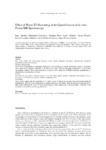Effect of water T2 shortening in the quantification of in-vitro proton MR spectroscopy

Use this link to cite
http://hdl.handle.net/2183/17435Collections
- GI-RNASA - Artigos [195]
Metadata
Show full item recordTitle
Effect of water T2 shortening in the quantification of in-vitro proton MR spectroscopyAuthor(s)
Date
2015-05-21Citation
Hernández-Tamames JA, Mato Abad V, García-Álvarez R, González-Zabaleta J, Pereira Loureiro J, Álvarez-Linera J. Effect of water T2 shortening in the quantification of in-vitro proton MR spectroscopy. J Neuroimaging. 2016;26(1):58-61
Abstract
[Abstract] PURPOSE. This work studies the relationship between in-vitro Proton Magnetic Resonance Spectroscopy metabolite quantification and water T2 decay.
MATERIALS AND METHODS. An in-vitro correspondence is established between the iron accumulation and the shortening of water T2 relaxation times using seven spherical phantoms, 6 of them were doped with an increasing concentration of iron metal nanoparticles solution. This is later proposed as a source of error during the LCModel metabolite quantification of either absolute concentrations or ratios.
RESULTS. The Pearson's correlation coefficient between water T2 values against absolute metabolite concentrations was on average [r] = 0.97 and on average [r] = 0.85 for metabolite ratios.
CONCLUSION. These results suggest that the shortening of T2 values should be taken into account when performing metabolite quantification. Also, the need of demonstrated similar results in in-vivo studies, since the presence of iron deposits or other factors affecting the water T2 decay measurements could explain part of the inter-subject variability in the metabolite concentration and ratio quantification.
Keywords
Water T2 relaxation time
Magnetic resonance spectroscopy
Iron
Metabolite quantification
Magnetic resonance spectroscopy
Iron
Metabolite quantification
Description
Short communication
Editor version
Rights
This is the peer reviewed version of the article which has been published in final form at Wiley Online Library. This article may be used for non-commercial purposes in accordance with Wiley Terms and Conditions for self-archiving.





